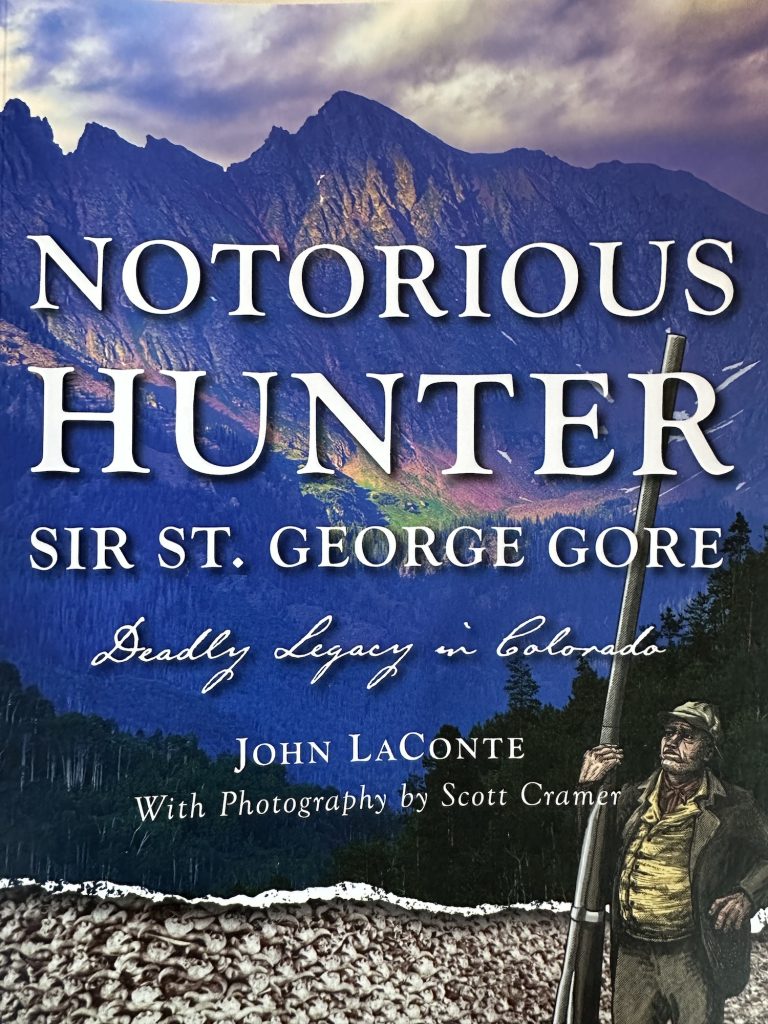 Vail Daily reporter John LaConte poses at the Vail Daily office with his new book, “Notorious Hunter: Sir St. George Gore.” This is LaConte’s first book.
Vail Daily reporter John LaConte poses at the Vail Daily office with his new book, “Notorious Hunter: Sir St. George Gore.” This is LaConte’s first book.
Tricia Swenson/tswenson@vaildaily.com
John LaConte says his job as a reporter is to investigate claims. That is what led him to write a book about the infamous Sir St. George Gore, better known around the Vail Valley by the misnomer “Lord Gore.” Landmarks such as the Gore Range, Gore Pass, Gore Lake, Gore Canyon, Gore Creek and Gore Creek Drive were named after the mysterious Anglo-Irish hunter who came to North America in the 1850s.
“I’d always been a Gore nerd, and even had a book called ‘The Amazing Adventures of Lord Gore: A True Saga from the Old West’ published in 1977 by Jack Roberts, an artist whose paintings were in the old Lord Gore Restaurant in Vail,” LaConte said. “The next book I found written about Gore was ‘Baronet in an Earth Lodge,’ by Barry C. Johnson of The English Westerners Society. It was written 20 years later and cleared up a lot of the misconceptions from the first book, but it was never widely published, so the first attempt to clear a lot of that up went unnoticed. It still seemed like the legend of Gore had just completely spiraled out of control and had been accepted as fact.”
There were many unanswered questions that LaConte wanted to investigate. He credits the digitization of old newspapers, books, journals and other writings in helping him develop a timeline of Gore’s travels. Using newspaper articles and personal journals written by those who met Gore, LaConte started to piece together the man behind the name that is so associated with the Vail Valley. The result is LaConte’s debut book, “Notorious Hunter: Sir St. George Gore.”
“I think we’re in a golden era of research opportunities now with digitization,” LaConte said. “The simple fact that newspapers have been digitized, you can now strike from history a lot of false claims.”
In the summer of 2023, LaConte, his wife and two kids camped near Gore Pass. LaConte knew about a monument to Sir St. George Gore and found it had been vandalized when they came upon it. The mystery surrounding the name that LaConte had heard of since he was a kid visiting his grandmother, who lived in Vail, struck a chord. He wanted to utilize his investigative journalism skills to explore the answers.

Support Local JournalismDonate
He told his editor at the Vail Daily, Nate Peterson, about his idea, and Peterson encouraged him to write a book and seek advice from Kathy Heicher, a local author and historian with the Eagle Valley Historical Society. She put him in touch with History Press, a division of Arcadia Press that publishes works about history and culture from communities across the nation.
 Vail Daily reporter John LaConte teamed up with local artist Andrew Odlin and photographer Scott Cramer to create his new book, which was published by History Press and came out on Tuesday.Tricia Swenson/tswenson@vaildaily.com
Vail Daily reporter John LaConte teamed up with local artist Andrew Odlin and photographer Scott Cramer to create his new book, which was published by History Press and came out on Tuesday.Tricia Swenson/tswenson@vaildaily.com
Hunting and traveling in style
Sir St. George Gore came from a family of wealthy baronets in Ireland, but much of the Gore family moved to England. They became absentee landlords in Ireland during the Great Famine. Gore, who fancied sport, made many trips to and set up residence in Scotland.
LaConte uncovered many writings of Gore’s fishing and hunting exhibitions. Gore had the best equipment of the day, including a punt gun, which was twice the size of a man and could kill 50 ducks with a single shot. It was also reported that he was one of the first to use a “particular Irish fishing rod on the Ness” that became the preferred piece of equipment for anglers there.
Although Gore’s presence was recorded in Colorado, his travels took him from Europe across the Atlantic and into North America via Montreal, Quebec, Canada. There were also records of him going to St. Louis and New Madrid, Missouri; Sycamore, Illinois; the Shawnee Mission area near modern-day Kansas City; Jacksonville, Florida; Fort Kearney, Nebraska; The Black Hills of Wyoming and South Dakota, and various areas in North Carolina, Tennessee, Louisiana, Texas and even Mexico.
The numbers vary, but once Gore came to North America, some accounts say he traveled in a fine carriage, had numerous wagons for all of his equipment and teams of oxen to pull those wagons, food and supplies, plenty of hunting dogs, horses, cattle, guns, ammunition, fishing tackle and top shelf liquor and wine that he would drink out of silver cups. His tent was a large linen structure with a brass bed frame that could be taken apart for transport, animal hide and fur rugs and a large telescope on a tripod. He also had many servants who were described as having powdered hair and knee breeches. If he needed a boat to travel up or down a river, he would either buy one or have his team build one.
Other accounts have been written about the number of animals he may have killed, but LaConte points out that at that time, the U.S. military was enticing people to kill buffalo and other animals.
“It was policy, it wasn’t just cruelty,” LaConte said.
Colorado’s first recreational tourist
It was well known that Gore did everything to excess. He had big ideas and money to back them up and a desire to hunt wherever he wanted. When one such desired hunting location was hampered by the lack of a road over a mountain pass, Gore simply commanded that a road be built to get him and his party over it. That first primitive road was called Gore Pass. Jim Bridger, an accomplished, reliable and trusted guide and legendary mountain man who accompanied Gore on many of his excursions, coined the term.
“Bridger understood that outdoor recreation was already creating a new market here in the West,” LaConte said. “There was only a couple of ways you could really make money. There wasn’t really much logging, mining or energy development yet. Bridger realized that outdoor recreation could actually become an economic driver for the region. In all his travels with Gore, he knew their party had created a roving hub of economic activity with vendors selling things and Gore buying things along the way.”
LaConte believes that Bridger knew how important it was that Gore had built the first road over the Continental Divide in western Colorado. Gore Pass is at 9,524 feet above sea level and located along the northern edge of the Gore Range, between Kremmling and Yampa and on the border of Routt and Grand Counties.
“It instantly made Gore a legend because the most important thing you could do to become a legend of the Old West at that time would have been to build a road,” LaConte said, who also reminds us in the book that Vail Pass was named after the builder of the road, as well, state highway engineer Charlie Vail.
“Even though it’s 170 years old, this story sort of teaches us a lot about today. Gore was a wealthy tourist seeking outdoor recreation.” LaConte said. “It reminds me of the old adage of ‘the more things change, the more they stay the same.’”
LaConte draws similarities between Gore’s hunting exhibition and the souped-up adventure vans that can travel deep into the wilderness with all the luxuries of solar panels and cooking equipment, a satellite phone, Starlink and other deluxe features.
“It’s like we are still just as excessive today in many ways,” he said.
 Vail sits at the bottom of the Gore Range and along Gore Creek. John LaConte, Vail Daily reporter and author of “Notorious Hunter: Sir St. George Gore,” worked with photographer Scott Cramer to show images of the many places that are named after Gore. Scott Cramer/Courtesy photo
Vail sits at the bottom of the Gore Range and along Gore Creek. John LaConte, Vail Daily reporter and author of “Notorious Hunter: Sir St. George Gore,” worked with photographer Scott Cramer to show images of the many places that are named after Gore. Scott Cramer/Courtesy photo
All over the map
Whether you are a general history buff, love to learn about Vail or like to hear about characters from the Old West, LaConte’s book is an interesting read. He stretches your imagination while thinking about Gore and his passion for sport and how he went about it.
“It’s crazy how he’s tangentially connected to so many historical events of the time,” LaConte said. “He’s mentioned in a journal associated with the Sioux Wars, he’s mentioned in newspaper articles documenting the discovery of gold in the Black Hills and other places, and he spent time with people who would become known for their role in the Civil War.”
Beyond answering lots of questions about Gore, his past, his travels across North America and his spending, LaConte hopes the book conjures up a little reflection.
“I do think that there’s a lot that we can learn about ourselves, where we are and where we’re headed, based on our past,” LaConte said. “And I think that this story has been lost and is important for us in order to understand ourselves here in Vail and, of course, across the whole Rocky Mountain West.”
“Notorious Hunter: Sir St. George Gore” will be available for purchase locally at the Colorado Snowsports Museum in Vail and the Bookworm in Edwards. To celebrate its launch, LaConte will host two book signing events this week. The Colorado Snowsports Museum on the top level of the Vail Village parking garage welcomes the author on Thursday from 5:30-7 p.m. and the Sitzmark Lodge invites LaConte to the lobby on Saturday from 3-5 p.m. The Sitzmark Lodge is located on the aptly named Gore Creek Drive in Vail Village along Gore Creek.

